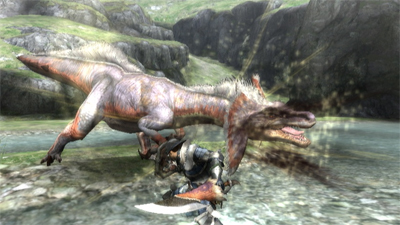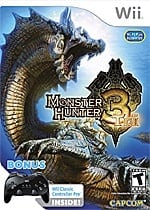The Thrill of the Hunt
January 21, 2009 – Reportedly, upon opening on the first day of last year’s Tokyo Game Show, it took a mere 10 minutes for a four-and-a-half-hour-long line to form to demo Capcom’s Monster Hunter Tri (tri-). The game was initially slated to release on PlayStation 3 but was then moved to Wii in an attempt to cut high production costs associated with developing for next-gen consoles. Considering the runaway success of the Wii and the insane popularity of the Monster Hunter series overseas, it sure seems like a match made in heaven. But what’s all the fuss about Monster Hunter anyway?

If there’s one thing Japanese gamers can’t seem to get enough of, it’s collecting stuff. Whether it’s Pokémon, loot in Phantasy Star games, or monsters in Dragon Quest, there’s something inherently addictive about acquiring virtual wealth. The Monster Hunter series is built upon a similar premise. Like Phantasy Star Online, the gameplay in Monster Hunter is based around a hub town where players can take on various quests. Rather than troll for loot, however, you’re tasked with, well, hunting monsters, of course. Payment for quarry affords you better gear, which in turn, allows you to take on bigger, badder monsters.
In addition to receiving rewards and glory for completed quests, the remains of defeated monsters often contain components for creating new weapons and items. This element of the gameplay, too, adds to the addictive nature of the Monster Hunter formula, and trading equipment online only takes it that much further.
Online gameplay is Monster Hunter Tri’s main attraction, after all. There are still many details yet to be revealed, but we do know players will, in this latest installment, be able to quest with others online without the need for friend codes. Friend codes do, however, play some role in online interactivity – and we suspect playing with friends will carry with it a few unique benefits – but Capcom has yet to offer specifics.

When playing online, hunters can meet at a central hub town (lobby). From there, players can trade gear or hook up with other folks to take on quests. Though actual hunting expeditions are restricted to parties of up to four players, the lobby system does present the promise of a larger, online social structure – a first for Wii.
Past games in the series offered various types of quests, and though players could experience a lot of what the game had to offer by merely hunting alone, the real value of Monster Hunter games has, undoubtedly, always come from the multiplayer component. Beginning with the first Monster Hunter, event quests offered players of all ranks new challenges on a regular basis, and we surely do hope these weekly hunts make a return in MH3. Incentives to keep players coming back for more would, in turn, allow the game’s online community to flourish, giving long-lasting value to the title. If this latest outing is anything like its predecessors, expect there to be a slew of items and monsters only attainable by way of venturing forth into the world of online play.

Ranking up in Monster Hunter is, however, the ultimate goal, so whether you’re gathering supplies or capturing new pets for the townsfolk, you’ll always want to keep your eyes on the prize. You won’t level up or gain experience; rather, only by moving up in hunter rank can you progress further in the game.
Since becoming a skilled hunter is key to your success, mastering the game’s updated controls will be essential. Players can choose to use either the Classic Controller or Wii Remote and Nunchuk. We’re especially interested in the latter option, since it affords players more than one way to approach various actions. For instance, you can either shake the Wii Remote or press the plus button to unsheathe your weapon. Additionally, when gathering, skinning, mining, or climbing, you can opt to either shake the Nunchuk or press the A button. Attacking is also executed with the A button, though you can change the angle of your attack by turning the Wii Remote in different directions.
In a first for the series, there will be underwater areas to explore, complete with new and unique monsters to hunt. Your character will have an air gauge you’ll need to keep track of, as well as a few unique moves that can only be executed under water. You’ll use the Wii Remote to point in the direction you want to move and press the B button to go there. Additionally, pressing the minus button lets you execute a tackle (or kick when on land) action.
A translucent mini-map stays onscreen while exploring, and you can toggle an item-selection menu at any time by pressing the C button. If you hold the Z button while moving, your character will perform a dash. The D-pad allows you to manipulate the camera.
In spite of the game’s move from PS3 to Wii, Monster Hunter Tri doesn’t seem to have suffered in terms of visual quality. The characters and monsters animate wonderfully, and the environments look better than ever. The lighting and water effects are impressive, as is the draw distance in the game, and textures exhibit a lot of well-designed detail. Beaches are lush, and the new monster models have an almost next-gen sheen. Additionally, underwater hunts offer a nice contrast never before experienced in the Monster Hunter series, and the view down there is looking particularly attractive.
Monster Hunter Tri is slated for release in Japan sometime later this year, and though a U.S. localization has yet to be confirmed, we’re confident we’ll eventually see the game make it Stateside. There are few games on the system that promise as much depth and none that can compare to Monster Hunter Tri’s online cooperative play. So, we’re greatly looking forward to learning more about this game in the coming months.
